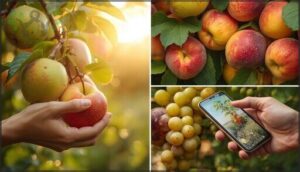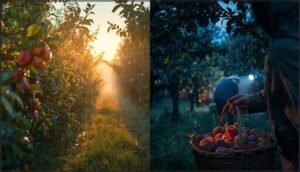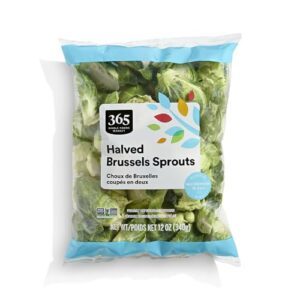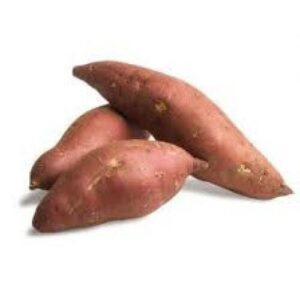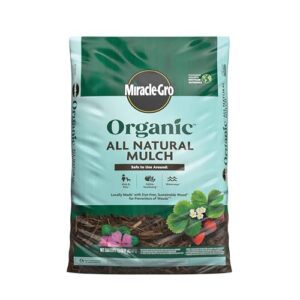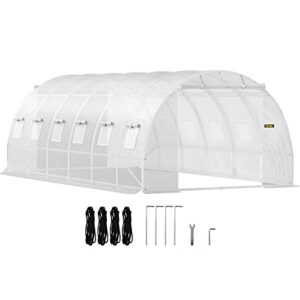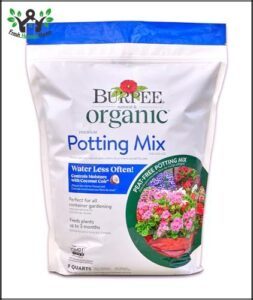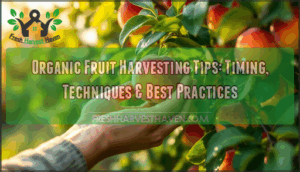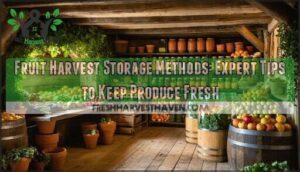This site is supported by our readers. We may earn a commission, at no cost to you, if you purchase through links.
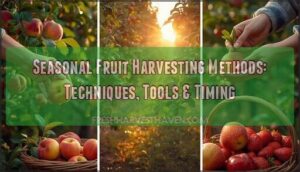
Your orchard’s sweetest apples might already be overripe while you’re waiting for the “perfect” weekend to pick them. Most growers lose 15–20% of their potential harvest simply because they misjudge timing or use techniques better suited for a different fruit entirely.
The difference between a strawberry that needs gentle pressure at the stem and a peach that yields to a careful twist isn’t just about protecting the fruit—it’s about preserving weeks of work and maximizing what your land can offer.
Seasonal fruit harvesting methods combine timing precision with fruit-specific handling, turning natural ripening cycles and regional climate patterns into strategic advantages that protect both quality and yield.
Table Of Contents
- Key Takeaways
- Essential Seasonal Fruit Harvesting Techniques
- Planning and Timing Your Fruit Harvest
- Tools and Equipment for Efficient Harvesting
- Sustainable Harvest and Storage Practices
- Top 10 Products for Successful Fruit Harvesting
- 1. Fresh Halved Brussels Sprouts Bag
- 2. Bonnie Plants Early Girl Tomato
- 3. Organic Sweet Potato Delight
- 4. Organic Butternut Squash Vegetable
- 5. Garden Plant Protection Netting Cover
- 6. Natural Organic Garden Mulch Solution
- 7. Portable Walk In Greenhouse Tunnel
- 8. Hydroponics Growing System Indoor Garden
- 9. Blackout Curtains For Bedroom Windows
- 10. Burpee Premium Organic Potting Soil Mix
- Frequently Asked Questions (FAQs)
- Conclusion
Key Takeaways
- Picking fruit at the right time and with gentle, fruit-specific methods preserves both flavor and yield, while preventing costly bruising and waste.
- Early morning or nighttime harvesting keeps fruit fresher and more nutrient-rich, thanks to cooler temperatures and reduced light exposure.
- Using the proper tools and post-harvest handling—like sanitizing pruners, foam-lined baskets, and quick cooling—extends both shelf life and market value.
- Smart harvest planning, including succession planting and paying attention to weather, regional calendars, and ripening signals, ensures a season-long, high-quality crop.
Essential Seasonal Fruit Harvesting Techniques
Knowing when and how to harvest your fruit can make the difference between a mediocre crop and one that bursts with flavor. You’ll need to rely on more than just your eyes—your hands, nose, and even the time on your clock all play a role in getting it right.
Here are the essential techniques that’ll help you pick fruit at its absolute peak.
Identifying Peak Ripeness for Different Fruits
When you’re aiming for peak flavor during fruit season, you’ll rely on visual color transitions—like green shifting to vibrant red or yellow—as your first clue to ripeness. Texture measurement through gentle pressure reveals firmness changes, while sugar content hitting 12–18°Brix ensures sweetness. Changes in fruit also affect its dry matter content.
Aroma profiles and automated detection systems can improve your harvest timing, guaranteeing you capture fruits at their nutritional and flavorful best.
Best Time of Day to Harvest Fruits
Morning vs. afternoon harvest timing greatly affects fruit quality and marketability. You’ll preserve up to 20% more nutrients and texture by picking just before sunrise, when cooler temperatures slow moisture loss.
Night harvesting benefits include 15% better flavor compounds and 3–5 times less under-skin browning. Nighttime harvesting can also improve fruit quality by minimizing temperature and light stress.
Temperature impact on shelf life is measurable—morning harvests reduce spoilage by 18% during storage, optimizing your harvest management throughout the season.
Proper Fruit Picking Methods (Twisting, Cutting, Pulling)
Once you’ve timed your harvest, the picking method you choose directly affects both fruit quality and labor efficiency. Twisting achieves about 60% success in tomatoes, but cutting delivers 88% success with kiwifruit while keeping damage below 10%. Pulling requires up to 12.8 newtons of force for apples, making it better for strong stems.
Combined methods—twisting and pulling citrus, or cutting then twisting clusters—can boost yield by 50% while reducing damage rates from 14% to under 8%.
Gentle Handling to Prevent Bruising
Your picking method sets the stage, but how you handle fruit afterward determines shelf life. Drop heights above 15 cm for firm fruit and 10 cm for softening varieties cause significant bruising. Train your crew to treat each piece like an egg—pressure over 10 newtons leaves visible damage within 48 hours.
Consider these post-harvest handling and care strategies:
- Keep drop heights minimal during collection and transport
- Use foam-lined containers to reduce impact forces by 80%
- Handle fruit with consistent gentle pressure across your team
- Cool harvested fruit immediately to slow bruising progression
Proper fruit storage starts with damage prevention at harvest.
Staged Harvests for Prolonged Picking Seasons
When you spread seasonal fruit harvesting across multiple passes, you’ll extend the harvest season by 15–20 days and boost marketable yield up to 10%. Staged harvests let you monitor ripening stages closely, improving postharvest quality through better fruit harvest planning.
This approach enhances labor force flexibility while production planning impact includes higher returns—pomegranates picked at best intervals command 15% premium pricing due to better economic outcome analysis.
Planning and Timing Your Fruit Harvest
You can’t just walk outside and pick fruit whenever you feel like it. The best harvests come from paying attention to weather shifts, riening cues, and the natural rhythm of each growing season.
The best harvests come from reading weather shifts, ripening cues, and the natural rhythm of each growing season—not from picking whenever you feel like it
In this section, you’ll learn how to read the signs that tell you exactly when your fruit is ready to pick.
Using Weather and Temperature Patterns
Weather patterns shape your harvest success more than you might realize. Temperature monitoring through forecast applications and predictive models helps you anticipate best picking windows—fruit maturation accelerates up to 30% when daily temperatures rise just 5°C above normal.
Technology advances now offer real-time alerts, reducing post-harvest losses by 13%. You’ll also avoid extreme events that can drop yields by 20% during sensitive growth phases.
Monitoring Ripening Stages
Monitoring ripening stages means tracking ethylene production, color changes, and firmness testing to nail harvest timing. Modern gas sensors detect ethylene from 5 to 1,000 ppm with impressive precision, while image-based systems achieve 97% accuracy classifying fruit ripeness.
You’ll also benefit from scent analysis and sugar content measures—combined metrics improve your predictions during fruit season, ensuring peak flavor when harvest season arrives.
Monthly and Regional Fruit Harvest Calendars
You can’t manage what you don’t measure, and that’s especially true for harvest timing. Strawberries ripen early spring through late June, while blueberries peak in August. Regional variations matter—California produces 90% of U.S. strawberries, and Washington grows nearly 70% of fresh apples.
Climate impacts shift fruit availability dramatically, so track calendar trends for your zone. Understanding seasonal harvesting patterns transforms your fruit harvesting results during harvest season.
Succession Planting for Continuous Yield
Staggered plantings turn your garden into a harvest machine that delivers fresh fruit week after week. By sowing crops at 7- to 21-day intervals and selecting early, mid, and late-maturing varieties, you’ll extend picking seasons and improve space efficiency. Here’s how succession planting maximizes continuous yield:
- Plant a quarter of your seeds every 14 days for ongoing cycles
- Choose varieties with 75- to 100-day maturity ranges
- Replace harvested crops immediately with heat-tolerant types
- Interplant fast growers among slower ones for concurrent harvests
- Use transplants post-harvest to shorten crop cycles by 25%
Timing Harvests for Maximum Flavor and Nutrition
Peak flavor and maximum nutrition depend on knowing when a fruit’s natural chemistry hits its stride. Harvest planning and timing shouldn’t rely on guesswork—Brix level impact, ripeness indicators, and texture at harvest guide your decisions.
Check this harvest window breakdown for harvest optimization:
| Fruit Type | Harvest Timing Indicators |
|---|---|
| Peaches | Brix levels exceed 12°; flesh softens |
| Bananas | Color shift; sugar peaks at ripening and antioxidants rise |
| Avocados | Early harvest time boosts phenolic content |
| Berries | Deep color; firm texture at harvest prevents spoilage |
Proper harvest time preserves ripening and antioxidants while locking in peak flavor.
Tools and Equipment for Efficient Harvesting
The right tools make all the difference between a frustrating harvest and an efficient one that protects your precious fruit. You’ll need equipment that treats each variety gently while helping you reach, cut, and collect without causing damage.
Let’s look at the essential tools that’ll transform your harvesting experience from amateur hour to professional operation.
Essential Hand Tools (Pruners, Knives, Scissors)
In fruit harvesting, hand tools are your bread and butter. Effective pruning, sharp knife skills, and ergonomic scissor grips make all the difference. Remember:
- Choose the right pruner blade types for each crop.
- Practice knife sharpening techniques regularly.
- Prioritize scissor ergonomics.
- Always disinfect tools.
- Invest in injury prevention.
Smart tool selection promotes better fruit picking and best storage.
Collection Baskets and Ergonomic Picking Bags
After you’ve sorted out your hand tools, turn your attention to how you’ll carry your harvest. Modern collection baskets balance capacity optimization with basket ergonomics—standard blueberry baskets hold 3.5 liters and wear comfortably around your neck.
For worker comfort and damage prevention, ergonomic picking bags with hip belts reduce shoulder strain by 71% while protecting delicate fruit during seasonal harvesting techniques.
Mechanized Harvesting Tools and Their Uses
Your harvest hauls deserve smart backup. Mechanized harvesting tools boost agricultural productivity, offering swift, damage-reducing harvests even under labor shortages. Here’s where technology works for you:
- Automated fruit picking machines with AI integration for selective harvesting
- Self-propelled harvesters boosting ROI in fruit production
- Sensor-equipped tech to fine-tune techniques and reduce bruising
- Regular maintenance guards against high costs in agriculture’s high-output landscape
Specialized Fruit Picking Devices
Beyond mechanization, robotic fruit pickers are reshaping orchards with AI-powered harvesting that spots ripeness in real-time, cutting waste and damage. Market adoption rates are climbing fast, driven by labor shortages and the need for gentle fruit damage reduction.
Handheld devices still dominate—capturing 38.2% of 2023 sales—thanks to picking device ergonomics and affordability.
Smart sensors now guide your fruit harvest planning, optimizing techniques for quality and storage.
Cleaning and Maintenance of Harvest Tools
Regarding gardening and harvesting, tool sanitation is your first line of defense against contamination risks. Regular cleaning frequency—ideally daily or as conditions demand—helps prevent the spread of microbes.
Disinfection agents, like diluted bleach or alcohol-based solutions, target pathogens.
Keep an eye out for design flaws in tools; rough welds or crevices hinder proper cleaning and affect fruit harvesting and storage safety.
Sustainable Harvest and Storage Practices
Getting your fruit off the tree is just the beginning—what you do in the hours and days after harvest determines how long your crop stays fresh and flavorful. Smart storage practices, combined with sustainable soil management, protect both your current harvest and future yields.
Let’s walk through the essential techniques that bridge the gap between picking and enjoying your seasonal bounty.
Immediate Post-Harvest Cooling Techniques
Think of rapid cooling as hitting the pause button on your harvest’s clock. Forced-air cooling systems remove 87.5% of field heat within hours, extending shelf life by up to 300% for perishable crops.
You can also try hydrocooling methods for water-tolerant fruits, vacuum cooling for delicate produce, or ice slurry systems.
These post-harvest handling techniques slash ethylene production by 60% while boosting disease suppression against common molds.
Proper Storage Conditions for Different Fruits
Temperature control and humidity needs determine how long your harvest stays fresh. Store apples at 30–40°F with 90–95% humidity for up to 12 months, while berries require 32–35°F for just 2–7 days. Citrus thrives at 50–60°F.
Proper food storage maintains nutritional quality and extends shelf life—strawberries hold more vitamin C at cooler temperatures, preserving post-harvest care efforts.
Separating Ethylene Producers and Sensitive Fruits
Apples, bananas, and tomatoes produce ethylene gas that accelerates ripening—and can ruin your leafy greens and carrots in days. Storing high ethylene producers separately from sensitive crops will extend shelf life considerably. Use dedicated bins or refrigerator drawers for each group.
This simple food preservation step reduces spoilage, protects post-harvest care investments, and maintains best fruit storage conditions for maximum freshness.
Monitoring and Preventing Spoilage
Real-time Spoilage Detection Tech has reshaped food storage and preservation, offering eyes sharper than any human inspector. By monitoring your storage environment and applying sophisticated Quality Control, you’re hitting the brakes on spoilage before losses mount.
Pair Microbial Surveillance with careful Injury Reduction and diligent post harvest care, and you’ll extend shelf life and protect the fruits of your labor.
Eco-Friendly Crop Rotation and Mulching
A thriving harvest starts underground—Sustainable Farming Practices like crop rotation and mulching do more than feed your plants. Rotate crops to boost soil fertility, reduce pests, and even store carbon right in your rows.
Add organic mulch for water conservation and a biodiversity boost. These Soil Management and Conservation approaches are cornerstones of Environmental Sustainability in Agriculture you can put into practice today.
Top 10 Products for Successful Fruit Harvesting
Choosing the right tools and supplies can make a world of difference when harvesting fruit. Every product on this list has a specific purpose to help you get the most from your hard work.
Here are ten essentials that can help you harvest smarter and protect your yield.
1. Fresh Halved Brussels Sprouts Bag
A fresh halved Brussels sprouts bag offers practical Halved Sprout Benefits for both home cooks and growers. Harvested and prepared for convenience, these vegetables save time while maintaining peak flavor and nutritional value.
Washing Recommendations are key—clean each piece before use. Proper storage techniques extend Storage Freshness, so refrigerate promptly and check for spoilage often.
From roasting to quick sautés, Recipe Ideas for these halved sprouts abound. Their well-documented Consumer Acceptance demonstrates why they’re a smart seasonal choice for fruit and vegetable enthusiasts.
Best For: People who want a quick, healthy veggie that’s easy to prep and works in lots of recipes.
- Convenient—already halved and ready for fast cooking or meal prep.
- Triple-washed and high quality, with great texture and mild flavor.
- Versatile for roasting, sautéing, microwaving, or boiling.
- Needs to be washed again before eating for best safety.
- Not a good pick if you don’t enjoy Brussels sprouts.
- Freshness depends on storage and how soon you use them.
2. Bonnie Plants Early Girl Tomato
After prepping those Brussels sprouts, you’ll want a crop that produces just as reliably—enter the Bonnie Plants Early Girl Tomato. With an early harvest window of about 50 days, these plants set the bar for Productivity Yield.
They’re prized for exceptional Early Girl Flavor, thriving with solid Disease Resistance and a steady Planting Timeline. Gentle Harvest Handling matters here since fruit bruises easily; pick when Ripeness means full color and slight give.
These indeterminate plants reward careful, Seasonal Harvesting with consistent harvests through changing weather.
Best For: Gardeners who want fresh tomatoes fast and don’t mind staking tall plants for a season-long harvest.
- Delivers ripe tomatoes in just 50 days, so you can enjoy homegrown slices weeks before most varieties.
- Keeps producing all summer long thanks to its indeterminate growth, giving you multiple pickings instead of one big harvest.
- Shrugs off common diseases like verticillium and fusarium wilt, so you spend less time troubleshooting and more time picking.
- Plants sometimes arrive dried out or smaller than expected, which means you might need to nurse them back to health.
- Grows tall and needs solid support like a cage or stake, adding extra setup work to your garden.
- Fruit bruises easily during harvest, so you’ll need a gentle touch and can’t just toss them in a bucket.
3. Organic Sweet Potato Delight
While tomatoes shine early, sweet potatoes demand patience—your Harvest Timing shifts to a 112-day window. This Vegetable and Fruit Harvesting Guide emphasizes Seasonal Harvesting when soil’s warm and foliage yellows—that’s when you’ll unearth 1.99-pound organic gems packed with beta-carotene.
Organic Potato Sales jumped 9.2% as the Sweet Potato Market hit $37 billion, driven by Consumer Preferences for nutrient-dense roots.
Your Harvest Strategy centers on proper Weed Management; keeping fields clean for 24 days prevents 76% yield loss. Harvesting Techniques require gentle handling since roots bruise easily.
Best For: Home cooks and health-conscious eaters who want organic, versatile sweet potatoes for everything from weeknight sides to meal prep, and don’t mind paying a premium for quality.
- High nutritional value with plenty of beta-carotene, fiber, and vitamins that support a healthy diet
- Organic certification means no synthetic pesticides or GMOs, which matters if you’re particular about what you eat
- Really versatile in the kitchen—works for roasting, mashing, baking, or even making fries
- Price point is higher than conventional sweet potatoes, which some customers feel is steep
- Shelf life can be hit-or-miss, with some reporting they go stringy or spoil faster than expected
- Size inconsistency is an issue—some are too large and harder to work with than regular potatoes
4. Organic Butternut Squash Vegetable
If you’re weighing options for nutrient-packed fall crops, Organic Butternut Squash stands out for both flavor and storage. Harvesting Butternut Squash at peak—when the rind hardens and stems shrivel—safeguards taste and shelf life.
This Vegetable and Fruit Harvesting Guide emphasizes proper curing and storage; keep squash in cool, dry conditions for up to three months.
With impressive butternut squash nutrition—400% daily vitamin A per serving—and versatility in butternut squash recipes, it’s both a reliable staple and a highlight of seasonal harvesting.
Best For: Home cooks and health-conscious eaters who want a versatile, nutrient-dense ingredient for fall and winter meals—especially if you have proper storage space and enjoy both savory dishes and baking.
- Exceptional nutritional profile with 400% daily vitamin A and 27% daily vitamin C per serving, plus fiber and antioxidants with zero fat or cholesterol.
- Impressive shelf life of 2 to 3 months when properly cured and stored, making it a reliable pantry staple through the season.
- Extremely versatile in the kitchen—works beautifully roasted, puréed for soups, mashed for casseroles, or baked into breads, muffins, and pies.
- Size inconsistency can be frustrating, with some customers receiving very large squash while others get unexpectedly small ones.
- Larger specimens may be impractical for individuals or small households, leading to potential waste if you can’t use it all.
- Requires specific storage conditions (50–55°F and moderate humidity) to maintain freshness, which not all kitchens can easily provide.
5. Garden Plant Protection Netting Cover
Protecting your ripening fruit from birds and insects can mean the difference between a bountiful harvest and bare branches. Garden Plant Protection Netting Cover—especially ultrafine mesh between 0.3 and 0.6 mm—offers proven pest exclusion efficacy, reducing green June beetle and bird activity to zero in controlled trials.
Different netting material types provide climate moderation by blocking up to 70% of solar radiation, while allowing water and air through. Installation best practices call for deployment after pollination but before pest pressure peaks.
Though drape netting costs around $3,000 per acre versus $9,000 for permanent structures, the economic considerations favor this investment when you’re committed to crop protection and management. Choose UV-resistant options for multi-season durability in tree care and fruit gardening strategies.
Best For: Home gardeners and small-scale growers who want reliable, chemical-free protection for fruits, vegetables, and flowers throughout the growing season.
- Blocks birds, insects, and pests without chemicals, boosting yields and fruit quality.
- Lets sunlight, rain, and air through so plants stay healthy and easy to maintain.
- Durable and reusable for several years with proper care.
- Needs secure anchoring to prevent wind from blowing it away.
- May be hard to see through in bright sunlight and could tear with rough handling.
- Might require extra support or clips, which can create holes or add setup time.
6. Natural Organic Garden Mulch Solution
Between your fruit trees and thriving harvests, organic garden mulch plays a critical role in soil management and sustainable gardening. This locally made solution applies at 0.25–0.50 kg/m² to suppress weeds while moderating soil temperature fluctuations during summer heat.
Its mulch composition—recycled green waste and sustainable wood—enhances nutrient cycling as beneficial bacteria populations increase by up to 3%. You’ll retain moisture, reduce erosion by 25%, and boost fruit quality through improved sugar content.
Apply 3-inch layers using proven gardening techniques, and you’re setting the stage for seasons of success.
Best For: Eco-conscious gardeners who want a sustainable, pet-safe mulch that prevents weeds, retains soil moisture, and improves long-term soil health around edible gardens and ornamental plants.
- Locally manufactured from recycled wood waste and OMRI listed for organic gardening, making it safe for use around vegetables, fruits, and pets when applied correctly.
- Reduces weeds by blocking sunlight, cuts soil erosion by up to 25%, and moderates temperature swings during hot weather—all while boosting beneficial soil bacteria.
- Improves fruit quality and crop yields by enhancing nutrient cycling and moisture retention, with research showing increased sugar content in produce.
- Takes a long time to absorb water initially, which can be frustrating during the first watering after application.
- Not suitable for use around young seedlings, underdeveloped plants, or directly against tree trunks and wooden structures due to potential moisture damage.
- Individual box packaging may create unnecessary waste for larger garden projects where bulk options would be more practical.
7. Portable Walk In Greenhouse Tunnel
When season extension dictates harvest success, a portable walk-in greenhouse tunnel becomes your controlled-climate ally for optimizing fruit production. This 20x10x7-foot structure features galvanized steel framing and UV-resistant PE covering, supporting greenhouse assembly in under two hours.
You’ll achieve yield optimization through 12 mesh windows providing climate control while protecting delicate fruits from frost. Material durability concerns exist—covers may require replacement after 18–24 months—but cost analysis reveals construction averaging $1–2 per square foot.
Strategic fruit harvest planning within these tunnels extends your fruit season by 6–8 weeks, maximizing returns on temperature-sensitive crops.
Best For: Home gardeners and small-scale growers who need an affordable way to extend their growing season and protect plants from unpredictable weather without investing in a permanent structure.
- Easy setup in about two hours with included tools, plus 12 mesh windows give you excellent airflow to prevent overheating and keep plants healthy.
- Extends your growing season by 6–8 weeks, letting you start earlier in spring and harvest later into fall for better yields on temperature-sensitive crops.
- Budget-friendly at $1–2 per square foot, this 20×10-foot greenhouse gives you serious growing space without the cost or commitment of a permanent greenhouse.
- The PE cover typically needs replacement every 18–24 months due to wear from sun exposure and weather, adding ongoing maintenance costs.
- Not built for extreme weather—high winds or heavy snow can damage the structure, and the included stakes may not provide enough stability in storms.
- Zippers and seams are common weak points that can break or tear, especially with frequent use of the roll-up doors.
8. Hydroponics Growing System Indoor Garden
When you’re aiming for year-round fruit production beyond traditional season extension, a hydroponics growing system indoor garden transforms your approach to controlled-climate horticulture. This 12-pod system delivers hydroponic fruit yields up to five times faster than soil methods, using 90% less water through recirculating nutrient growth optimization.
You’ll manage pH between 5.5–6.5 for tomatoes, peppers, and strawberries while the 24W LED reduces energy infrastructure demands by 40%.
Market adoption trends show this technology reaching $8.7 billion by 2033, making water resource efficiency accessible for serious growers pursuing continuous greenhouse-quality harvests indoors.
Best For: Gardeners who want to grow fruiting crops like tomatoes, peppers, and strawberries year-round indoors with minimal water use and faster harvest cycles than traditional soil methods.
- Grows plants up to 5 times faster than soil while using 90% less water through its recirculating system, making it highly efficient for continuous fruit production.
- The 24W LED grow light with three plant-specific modes reduces energy costs by up to 40% compared to traditional grow lamps and adjusts up to 21 inches for taller crops.
- Automated water pump and nutrient delivery system minimize daily maintenance while the ultra-quiet operation (under 20 dB) won’t disrupt your living space.
- Requires additional purchases like a pH meter and hydroponic fertilizer to maintain the optimal 5.5–6.5 pH range needed for fruiting plants.
- Some users report the LED light randomly turning off and the pump may develop noise issues or fail over time, requiring replacement.
- The 12-pod capacity and height limitations make it unsuitable for very tall plants or large-scale production compared to commercial hydroponic setups.
9. Blackout Curtains For Bedroom Windows
You mightn’t connect blackout curtains for bedroom windows with successful fruit harvesting, but temperature control makes all the difference when you’re managing indoor growing environments. These dual-purpose installations block 99.9% of light while reducing thermal energy loss by 25%, directly supporting consistent ripeness development in climate-controlled spaces.
Energy cost savings reach 10% on heating bills, which matters when you’re running supplemental lighting for off-season fruit picking. Market adoption trends show growers increasingly using installation materials that deliver both health sleep benefits and gardening efficiency improvements.
Best For: People who need complete darkness for sleep, want energy savings, or require precise temperature control for bedrooms or indoor growing environments.
- Blocks up to 99.9% of light and UV rays, improving sleep quality and privacy.
- Offers energy savings of up to 10% on heating and cooling bills.
- Dual hanging options and easy-care fabric make installation and maintenance simple.
- Color may look different depending on room lighting.
- Rubberized backing can make sliding the curtains less smooth.
- Some users have reported incomplete sets or mix-ups in their orders.
10. Burpee Premium Organic Potting Soil Mix
You’re building healthy roots and preventing common nutrient deficiencies when you choose Burpee Premium Organic Potting Soil Mix for container-grown fruit crops. This OMRI-listed blend combines coconut coir for moisture retention with slow-release plant food that delivers nutrients for up to three months.
Organic soil benefits include improved yields in strawberries, tomatoes, and blueberries, while sustainable composition fosters eco-friendly fruit harvest planning. The mix promotes seed germination rates above 85% and reduces soil-borne pests.
Proper timing and nutrient release directly impact your orchard care and maintenance success in both indoor and outdoor gardening and horticulture applications.
Best For: Home gardeners growing fruits and vegetables in containers or raised beds who want an organic, eco-friendly soil that feeds plants for months while promoting strong root development.
- Slow-release plant food provides nutrients for up to 3 months, reducing the need for frequent fertilizing
- OMRI-listed organic certification ensures it’s safe for growing edible crops without synthetic chemicals
- Coconut coir retains moisture effectively between waterings while improving drainage and aeration
- Higher price point compared to standard potting mixes on the market
- Some users report a strong smell that may be off-putting initially
- The 9-quart bag size may not be sufficient for larger gardening projects
Frequently Asked Questions (FAQs)
How do you prune fruit trees after harvesting?
You’ll want to prune fruit trees after harvest but before dormancy to improve light penetration and boost next season’s fruit quality.
Focus on removing dead, damaged, or crossing branches while sanitizing your pruners between cuts for disease control.
What pests commonly damage fruit during harvest season?
Fruit fly damage, moth larvae impact, and sap-sucking insects ravage your harvest. Weather pest influence amplifies fungal disease vectors, threatening fruit harvest planning.
Post-harvest handling and care demand vigilant orchard care and maintenance.
Can you harvest unripe fruit and ripen indoors?
Yes, you can harvest climacteric fruits like bananas, peaches, and tomatoes unripe—they’ll ripen indoors using ethylene gas application or consumer ripening methods. However, indoor ripening feasibility varies.
Nutritional impact comparison shows on-vine fruits retain better flavor and nutrients.
How does moon phase affect fruit harvest quality?
You’re “moon-struck” if you ignore lunar timing—fruit harvest planning reveals waxing phases boost sap flow and yield quantity, while full moon timing enhances nutrient composition, optimizes ripening patterns, reduces spoilage rate, and improves harvest timing across every fruit season and climate.
What companion plants improve fruit tree health?
Carefully chosen nitrogen-fixing companions like clover and vetch boost fruit tree health by enriching soil.
Marigolds, chives, and garlic offer pest control, while borage and bee balm support pollinator attraction, improving orchard management and overall fruit yield.
Conclusion
One day, the fruit you leave until tomorrow might be the sweetest you’ll never taste. Understanding seasonal fruit harvesting methods means you’re not just gathering produce—you’re preserving the seasons themselves, making the most of what your orchard gives, year after year.
As regional weather patterns shift and ripening windows change, your knowledge grows too. Each harvest becomes a lesson, and every technique you improve sets the table for stronger yields and richer flavors in seasons yet to come.
- https://www.tandfonline.com/doi/full/10.1080/14620316.2025.2520366?src=
- https://www.choicesmagazine.org/choices-magazine/theme-articles/emerging-technologies-theme/mechanization-efforts-in-fruit-harvesting
- https://treefruit.wsu.edu/orchard-management/harvest/
- https://www.arxiv.org/abs/2503.22809
- https://extension.usu.edu/yardandgarden/research/harvest-and-storage-of-vegetables-and-fruits

